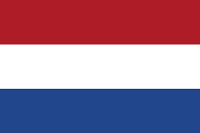![]() The Pacific War Online Encyclopedia
The Pacific War Online Encyclopedia
|
| Previous: Net Tenders (AN) | Table of Contents | Next: Netherlands East Indies |

The Netherlands are located in northwest Europe and
include most
of the Rhine delta. A disputed region from Roman times, the Netherlands
achieved its
independence as the United Provinces following the Thirty Years’ War in
1648.
The Kingdom of the Netherlands, as proclaimed at the Congress of Vienna
in 1815,
included Belgium, but in 1830 Belgium achieved its own independence and
the
Netherlands became almost synonymous with Holland, its most important
remaining
region.
Dutch explorers were very active in the 17th century and established a Dutch presence in both the West and East Indies. The Netherlands East Indies became the foundation of Dutch prosperity, with Java becoming a second homeland to the Dutch.
The Netherlands fell to the Germans in the spring of 1940, but
Queen Wilhelmina fled
with her government to Britain
and retained control of Dutch overseas possessions
and wealth. Dutch conduct at the outbreak of the Pacific war,
particularly the
failure to thoroughly demolish important oil
fields before they were captured by the Japanese,
must be understood in light of the fact that NEI oil fields were
financing the
Dutch contribution to freeing the Netherlands from Germany.
The Dutch in the Far East had been wary of Japanese intentions since the time of the First World War, and Womack (2006) reports that the Dutch feared a Japanese blitzkrieg campaign into the Netherlands East Indies in conjunction with the German invasion of the Netherlands. However, this failed to materialize due to Japanese reluctance to risk war with Britain and the United States. Japanese intelligence gathering in Dutch territory intensified, and, following a second invasion scare in February 1941, a virtual state of "cold war" existed during the remainder of the year. There were several incidents involving Japanese fishing vessels that the Dutch regarded as provocations, and the Dutch quietly began joint contingency planning with the British and Americans.
The Dutch government-in-exile declared war on Japan the day after the attack on Pearl Harbor, 8 December 1941 (London time). The Japanese,
however, did not declare war in turn on the Netherlands until 11
January 1942, possibly in the hope that this would delay the demolition
of Dutch oil fields until the japanese were ready move against them.
The Dutch naval squadron in the Netherlands East Indies had nothing heavier than a light cruiser. However, the ships were on the alert and at sea when war broke out, and Dutch submarines would be the first Allied naval units to draw blood.
The naval forces were organized into three Sea Forces (Zeemacht Nederlands-Indië). The Netherlands Indies Navy (Nederlands Indie Marine) controlled the submarine and mine warfare forces; Netherlands Indies Squadron (Nederlands Indië Eskader) controlled the cruisers and destroyers; and the Militarized Government Navy (Gemilitairiseede Gouvernementsmarine) or GM was the customs and patrol service, somewhat analogous to the U.S. Coast Guard.
The Dutch naval air service (Marine Luchts Dienst or MLD) was a small, highly professional, long service military organization that trained to operate in close cooperation with surface forces. This was particularly true in the Far East, where the flying boats of the MLD carried out reconnaissance over a vast area protected by a relatively small surface force. However, the MLD lacked combat experience. The decision to place MLD under the direct control of ABDA was resented by the Dutch, who correctly foresaw that the rapid forwarding of intelligence from the MLD to the surface forces that characterized prewar operations would break down under the more cumbersome command arrangement.
The Dutch skill at air-sea cooperation was illustrated on 22 December 1941, when a Dutch Do-24 guided submarine K-XIV towards a Japanese convoy headed for Kuching and then drew off the convoy's seaplane air cover while the submarine maneuvered to attack. K-XIV claimed four transports damaged or destroyed.
The Royal Netherlands East Indian Army (Koninklijke Nederlandse Indische Leger or KNIL) was composed largely of indifferently trained militia organized around a small cadre of regular troops. While some of the equipment was of high quality, there was not enough of it. For example, the KNIL had just four heavy antiaircraft batteries for the entire Netherlands East Indies in December 1941 (one 105mm and four 80mm batteries), plus about 104 40mm Bofors guns and a handful of other light antiaircraft weapons.
The air defense of the Netherlands East Indies was hampered by a lack of radar. After war broke out, the British installed a single radar set on Madura just north of Surabaya, but this was operated by British personnel and remained the only radar set in the Netherlands East Indies.
References
Womack (2006)The Pacific War Online Encyclopedia © 2006, 2014 by Kent G. Budge. Index